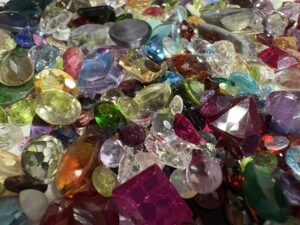
Has the Gem Faire come to a town near you? This, along with many similar events tour major cities, sometimes multiple times per year, providing an opportunity for the general public to purchase items they may not otherwise see in brick-and-mortar stores.
How do you know something is what it’s stated to be? Truth is, too often, you don’t. This doesn’t necessarily mean the vendor is trying to pull a fast one on you. Gem and bead dealers are notorious for not being able to fully authenticate pieces. They are vendors, and most often, not gemologists. While many semi-precious stones might be relatively easy to identify, it gets tricker when gems have a higher value. The gem trade is a business often built on trust, and here’s where it can get tricky…
I want to start of saying, I write from experience! It’s not fun contacting a company, whom I sincerely believe sold me something in good faith, to tell them their item(s) aren’t as stated. Most of the time, I believe, their supplier either was lied to or assumed. One bead vendor whom I’ve purchased many quality rare pieces from sold me their last strand of “Sleeping Beauty turquoise”. Before I create with gems, I aim to test them first, to ensure I’m accurately reselling them. In the case of the Sleeping Beauty material, a simple stereoscope was all I needed to learn, the beautiful color, tiny material I got was actually composite.
Another depressing lesson I learned by testing was “Tundra sapphire” bead strands is, they aren’t necessarily sapphire. Rather, it tends to be a trade name for colors of gems, I found to be mostly various types of garnet, zircon, peridot, and small amount of lattice diffused (color treated) sapphire. This very much is in violation of the Federal Trade Commission’s guidelines for disclosure. My online research confirmed my finding as well. Embarrassed by all this, the store had me mail the product back and issued me a full refund. They assured me they would never have sold the material ($40 a strand) had they known.
Gem shows and small businesses are full of unwary half-truths as well. For example, something might truly be earth mined sapphire or ruby, but they are either treated for color or glass filled to enhance clarity. These treatments are fine, if you know what you’re buying. There is a big price gap between all natural, untreated, and adulterated gems.
I feel like an episode of “Adam Ruins Everything”, right now. You might be wondering how to protect yourself.
—Consider whether you care about adulterations in the first place. Is the price right? Are you buying something for the color, etc..
—Do your research BEFORE you shop. Often a simple search online of, “how to tell if a ____ is real” can deliver informative reads. Pay attention to details, and take notes.
—Ask the seller about returns, and if possible, check the seller’s feedback rating online.
—Invest in a 10x triplet loupe to hone in on details.
—If it sounds too good to be true, it probably is.
—Purchase a small sampling, take it to an actual gemologist to have it tested. If all looks well, consider revisiting that seller again.
Photo by Melissa Johnson, copyright 2024
